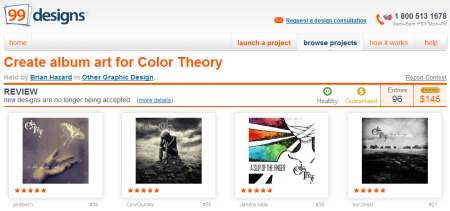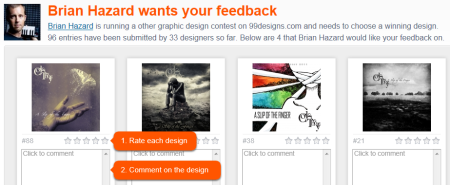
Quality graphic design is expensive. I paid $500 just to license the cover image for my last album, plus $600 for the rest of the design. That’s fine every couple of years, but now that I’m releasing songs individually, I need a cover design every month or two. I decided to give 99designs a try, and the results far exceeded my expectations. For $145, I got 96 custom designs from 33 different designers. Sure, some were amateur, but a solid half were usable, and a handful were excellent.
Sound too good to be true? Yes, it does. In fact, I hesitated to write this article. More on that later.
Contrary to what you might expect, 99designs doesn’t have an in-house design team. They host a design contest on your behalf, in which anyone can participate. As with any contest, there are winners and losers. That’s right - only the winner gets paid, though you can buy extra designs by selecting multiple winners. In my case, 95 of the 96 designs were done “on spec” i.e. for free. And you thought the music industry was cutthroat.
It takes all of five minutes to launch your own contest:
- Choose what you want designed. Prices start at $95 for a Twitter background, all the way up to $495 for a web site. “Print & Packaging Design” starts at $195, but since I only needed one image for digital release, I selected the “Other Graphic Design” category, starting at $145.
- Write the design brief. This is where you spell out to the designers exactly what you’re looking for (see mine here). I made it clear that my contest wasn’t intended to be a one-off gig, but the start of a working partnership. Perhaps that’s why I got so many entries.
- Set your price. There are three tiers to choose from: gold, silver, and bronze ($595, $295, and $145 respectively in the “Other Graphic Design” category). You can also name your own price, as long as it’s above the bronze package minimum. Presumably, the more money you offer, the better designers you’ll attract.
- Choose your preferences. Several other options are available. You can make the contest blind, so that only you can view the entries. You can guarantee the contest, ensuring designers that the prize money will be awarded. If you don’t, you’re free to back out at any time for a full refund. Finally, you can pay extra for a shorter than 7-day contest, or for extra visibility on the site.
Within a few hours, the designs started rolling in. I planned to just kick back and revel in the artistic brilliance, but corresponding with 33 designers quickly turned into a full-time job. Here’s how to keep your contest running smoothly:
- Eliminate hopeless causes. Some designers simply aren’t up to par, and though it seems cruel, you’ll be doing them a favor by eliminating them outright. I was seriously racked with guilt over the amount of work people were putting in, and figured the least I could do was provide plenty of feedback. That only encouraged them to try harder, which was ultimately a waste of everyone’s time.
- Steer the process. Provide ongoing feedback for all the designers on the main contest page. Believe it or not, I had to remind everyone that album covers are perfectly square (or at least in iTunes). After receiving dozens of entries featuring hands, I declared that theme officially played out. In retrospect, I should have insisted that designers get my approval on rough designs or photos before proceeding.
- Check for copyright violations. I used TinEye reverse image search to see if potential contenders matched other images on the web. If you’re the least bit suspicious, ask. If you’re not happy with the answer, eliminate. The best design in the world isn’t worth a lawsuit. Stock photos are acceptable, if clearly presented as such.
- Screen the designers. Grab some clues from their 99designs profile and Google away. Do they have a dedicated site hosting their portfolio? Look them up on Flickr, deviantART, Facebook, even Twitter. How responsive are they to your feedback? Is this someone you’d hire again?
- Get outside feedback. 99designs has a slick polling feature. You can create as many polls as you want to gather opinions privately, or solicit them publicly on your blog, Facebook, or Twitter. My fans made it abundantly clear which design they wanted, and as luck would have it, I was leaning that way anyway! Even if your mind is pretty much made up, a poll builds awareness of the release and gives fans a chance to participate in the creative process.

Why wouldn’t I do it again?
Shortly after launching my contest, two graphic designer friends voiced their disapproval, claiming that 99designs and other crowdsourcing sites erode the basic fabric and cost structure of the industry. One thing’s for sure: the format is absurdly inefficient. I shouldn’t be able to pay $1.50 per design, should I? That’s why I hesitated to write this article.
On the other hand, it’s a free market economy. If the risk isn’t worth the reward, don’t enter the contest! How is it different from pitching a song for a tip sheet, or entering a remix contest?
Then there’s the whole outsourcing angle. The winning designer in my contest is from Romania, where $145 is a decent week’s salary (EDIT: turns out they only receive $100, but the point remains). Should I pay four times as much to keep the money here in the US?
Tough questions for sure, but for now, I’ve got no reason to launch another contest. I’m happy to hire the winning designer, or several of the “losing” designers, first. Click on one of the thumbnails here to view their contest entries, and feel free to contact them directly. If you decide to launch your own contest on 99designs, please use my affiliate link.
Brian Hazard is a recording artist with sixteen years of experience promoting his eight Color Theory albums. His Passive Promotion blog emphasizes “set it and forget it” methods of music promotion. Brian is also the head mastering engineer and owner of Resonance Mastering in Huntington Beach, California.